Waving the myth that a wired mouse is better
Hello, Habr! I present to you the translation of the article “The mouse to end all mice” by Dave Gershgorn.
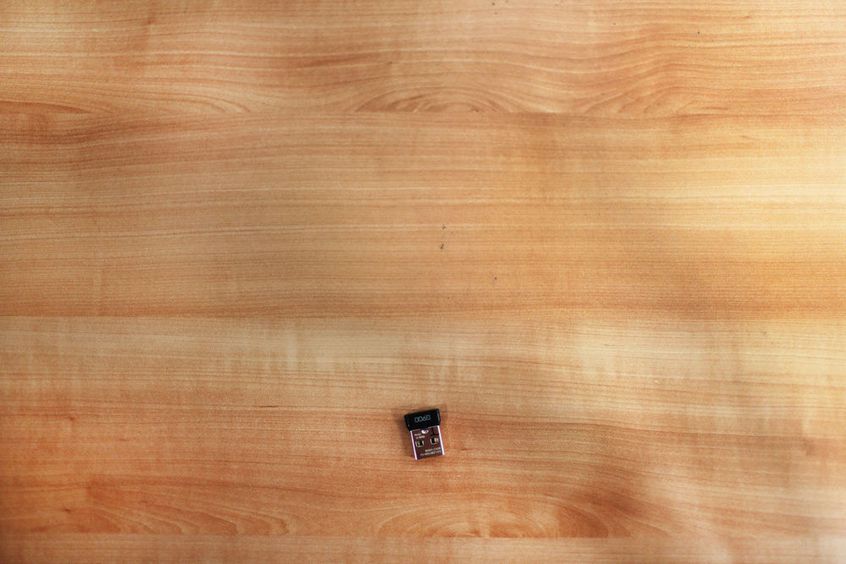
Logitech Chaos Spectrum Wireless Bluetooth Whistle
The new mouse concept claims that it is just as good or even better than its wired counterparts.
We live in a world where input devices are quickly becoming obsolete. The future is a rapidly changing concept, now filled with gesture recognition and a voice interface, and it certainly will not look the same as when the first mouse was launched on the market, and this, by the way, back in 1981.
But the basic concept of the mouse has remained unchanged for the past 25 years, and it is still the main gadget of desktop computers, especially for gamers. What has changed is the level of technology of this device. Advances in the development of sensors, microcontrollers and improvements in wireless protocols have allowed users to remain satisfied with products for many years, thanks to increased reliability, accuracy and speed of devices.
However, when it comes to wireless mice, there is a gap between theory and reality. Wireless mice are considered slower, less accurate, or unable to hold a charge long enough.
Logitech, a Swiss company known for its gaming peripherals, wants to destroy these unfair judgments with a single product.
Logitech Announces G900 Chaos Spectrum Gaming Mouse The wireless mouse is reported to respond faster than wired alternatives, and is immune to high levels of radio interference. It also weighs just 107 grams, which is about 20 grams lighter than its competitors. However, it is also stated that the battery lasts longer and the continuous operation time is 32 hours.
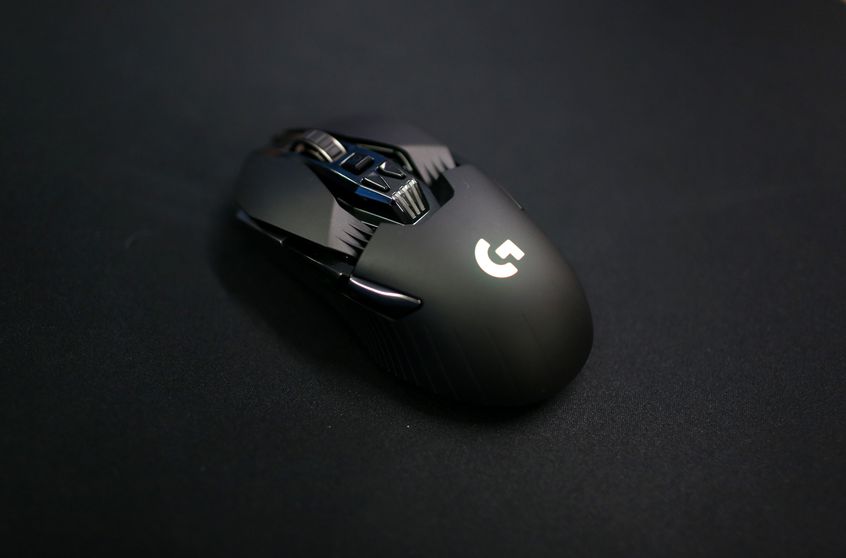
New Logitech G900 Chaos Spectrum Wireless Gaming Mouse
The G900 Chaos Spectrum has been developed for 3 years, a joint venture of Swiss and Irish research centers Logitech. The mouse is Logitech’s main trump card in the game for dominating the gaming peripheral market, and in this installment they created a professional wireless gaming mouse.
This is a pretty bold statement! So, Logitech invites us to Switzerland to prove this to us.
Logitech's Swiss headquarters is located on the hills next to Lake Geneva, on the campus of the Lausanne Polytechnic School, about an hour's drive from the city of Geneva.

Logitech test lab located on the campus of the Federal Polytechnic School in Lausanne, Switzerland
Here, the company conducts most of its wireless stability tests. Their laboratory is equipped with an anechoic chamber that allows full isolation from the outside world. This complex is also a haven for many non-standard solutions that can quickly bring wireless technology to the top of the gaming industry.
Some of Logitech's most successful products have been created in this laboratory, and this legacy is kept in small glass cases in many rooms. Posters adorn the patterned walls, and a visual representation of dry numbers emphasizes the advantages of the barely seeing the rodent G900 over its competitors.
Shelves mounted in an anechoic chamber are bursting with the abundance of gaming mice. And not just those born at Logitech. Here, the company tests its peripherals against its competitors by resorting to the standardized test that it developed.

Logitech is actively testing its own product against competitors, testing radio frequency interference and delays.
The mice are motionlessly fixed on thin transparent plastic, but the substrate, using the connecting rod mechanism, makes rotational-translational movements, that is, it moves in a circle, thereby forcing the mice to infinitely describe circles. The wireless mouse receiver is located about 100 centimeters away, and the cables connecting the receiver to the computer are pulled through a tiny hole in the camera wall. This uncomplicated invention, the staff of the complex called "Treadmill."
The mouse is configured for continuous operation, and on the computer you can see the perfect circles. The main feature of this camera is that the antenna located in the camera loads radio with interference, that is, wireless traffic on several bands and frequencies, such as Wi-Fi, Bluetooth and 3G. This simulates a loaded radio frequency environment, simulating the most difficult operating conditions.
When the mouse works in such conditions (this is a silent process) I watch this couple with two engineers from Logitech, who explain that the mouse can switch from one frequency to another in order to reduce the influence of the active frequency background. G900, unlike most competitors, continues to draw perfect circles, despite such strong interference.

Inside the anechoic chamber, the Logitech G900 is mounted on a device (jogger) that simulates the movement of the mouse on the surface.
After a few minutes, we switch to checking Razer Mamba, Logitech's largest competitor in the field. Under the same operating conditions, the "rodent" does not show its best side - the drawn circles begin to stretch and lose their shape.
The engineer explains that when competing mice change the operating frequency to another, this affects the quality of information input, which is why the circles are so flattened.
We test mouse after mouse, exceeding the average background by more than 20 times. No device described perfect circles except the G900.
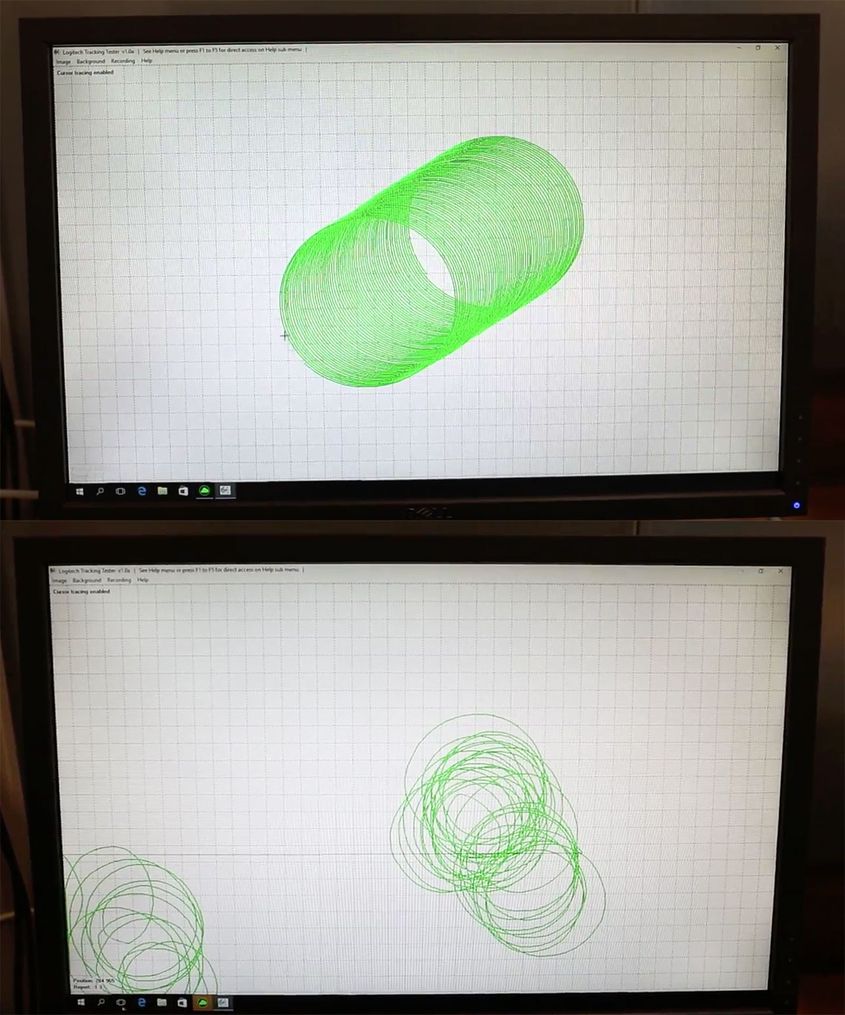
Above, the G900 is tested with strong interference. Below displays the work of a competitor mouse.
Logitech uses two delay measurement sensors. One measures the movement of the mouse in space, and the other measures the delay in clicks. The methods that they use are interesting, and the indicators speak for themselves, but it is important to remember that not every user can appreciate these innovations. A huge role is played by the hardware, in conjunction with which the mouse will function. Even with a 144 Hz monitor, a millisecond different between a G900 and a wired mouse means only one frame of the image. However, even just one shot can redraw the course of the battle and give an advantage on the battlefield to a player armed with the G900 mouse. Seconds are everything.

Logitech mouse click delay testing.
In tests for measuring click delays , a timer was connected to the mouse to determine the exact moment of the click, and then the USB analyzer recorded when the signal was received. The engineer then compares the delay between the physical click of the mouse and the received electronic signal.
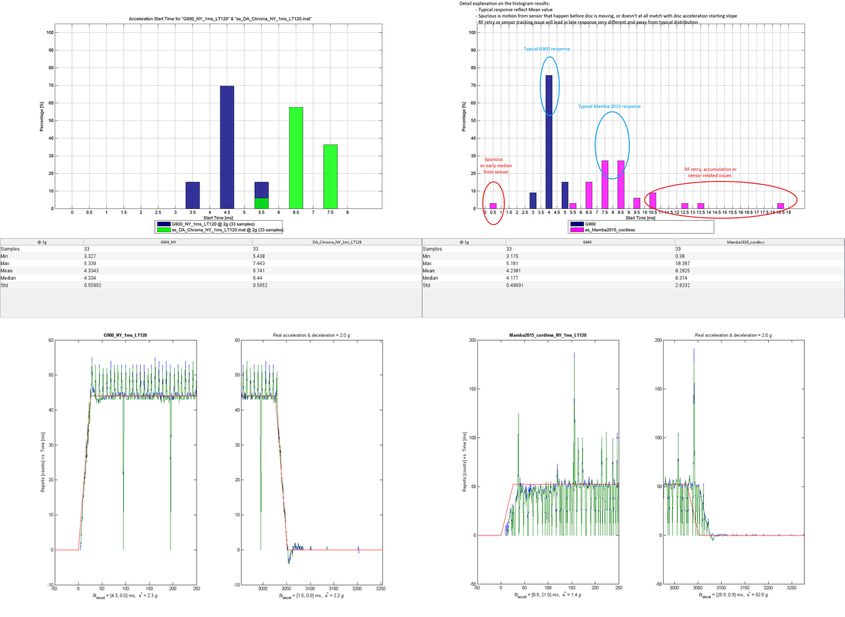
The top two charts show the test results for the G900, located to the left of the Razer DeathAdder Chroma (wired gaming mouse) and wireless Razer Mamba. In both tests, the response time of the G900 was faster. The two bottom charts show comparisons of the G900 on the left and the Razer Mamba. The smoother the wave, the better the device shows itself. G900 has some deviations from the ideal, but in general is more stable than Mamba.
Design and ergonomics are of great importance in the production of Chaos Spectrum. The result is a mouse that is structurally unlike its cousins.
Instead of mounting everything on a circuit board, the G900 has a composite design. The sensors and the board are obviously located at the very bottom of the mouse, but on top are two buttons for clicking the left and right mouse buttons of a modular design. To interact with the buttons, two, again, independent plastic keys are installed that provide a click when you click on them. Logitech engineers see this solution as an alternative to the universally accepted design solution and abandon the monolithic design of the case with keys.

An exploded view of the G900 Chaos Spectrum, on the right, has an additional platform with buttons. This is new even for Logitech, since switches are traditionally mounted on a circuit board .
All these technological solutions are aimed at improving the accuracy of the click, as well as to eliminate repeated or accidental clicks. Since the buttons are installed independently of each other, it does not matter what part of them is pressed. An office worker may not notice the innovation, but it is the exact click that brings the gamer closer to his virtual victories.
The fact that the keys move independently is also important. Each user's hand will be different from each other, therefore it is impossible to predict the location of the key, which will account for the majority of clicks. In monolithic execution, it is important to correctly position the fingers on the mouse, sometimes neglecting convenience, so that efforts are made to click only in a certain working area of the key. With independent key installation, this problem is still present, but significantly reduced. The idea is to create the most comfortable mouse grip, suitable for any user, without losing accuracy and functionality.
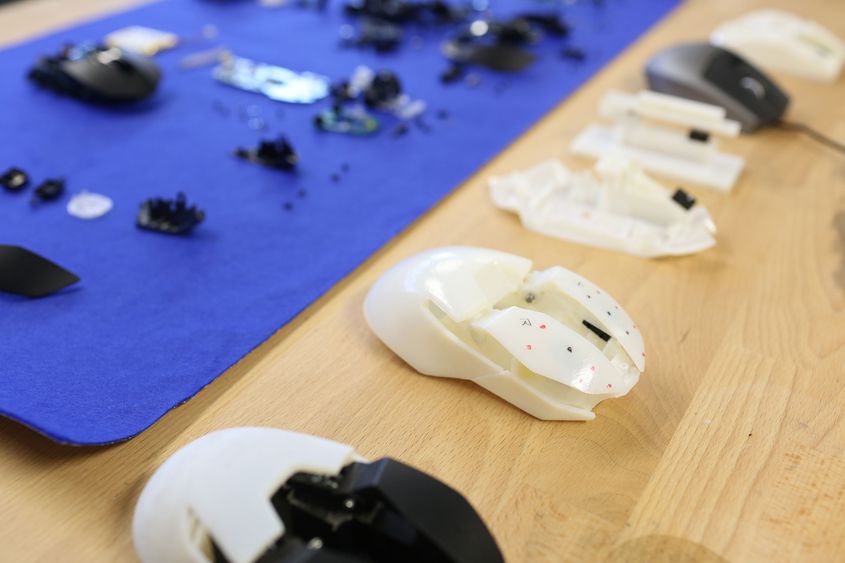
When developing prototypes of the mouse, key zones were identified that were most often subjected to user clicks.
The numbers don't lie and suggest that the G900 is a great mouse. In the hand, the "rodent" lies very conveniently and every click is clearly felt. The device is light enough, the hand will not get tired, and the user will feel comfortable for a long period of use
However, this mouse is unlikely to be required by the average user. It costs $ 150 and is developed by real pros for real pros. This is a formidable device in the hands of an experienced gamer.
Numerous banners and posters in the office hinted that wireless keyboards would also soon appear on the horizon. And this is good. We live at a time when huge amounts of money are being invested in the gaming industry. Every click and every wave of the palm is important for us - gamers. But somewhere in the mountains of Switzerland lurked a company that would never stop there.